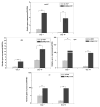The osteogenic differentiation of human bone marrow MSCs on HUVEC-derived ECM and β-TCP scaffold
- PMID: 22795852
- PMCID: PMC3427692
- DOI: 10.1016/j.biomaterials.2012.06.061
The osteogenic differentiation of human bone marrow MSCs on HUVEC-derived ECM and β-TCP scaffold
Abstract
Extracellular matrix (ECM) serves a key role in cell migration, attachment, and cell development. Here we report that ECM derived from human umbilical vein endothelial cells (HUVEC) promoted osteogenic differentiation of human bone marrow mesenchymal stem cells (hMSC). We first produced an HUVEC-derived ECM on a three-dimensional (3D) beta-tricalcium phosphate (β-TCP) scaffold by HUVEC seeding, incubation, and decellularization. The HUVEC-derived ECM was then characterized by SEM, FTIR, XPS, and immunofluorescence staining. The effect of HUVEC-derived ECM-containing β-TCP scaffold on hMSC osteogenic differentiation was subsequently examined. SEM images indicate a dense matrix layer deposited on the surface of struts and pore walls. FTIR and XPS measurements show the presence of new functional groups (amide and hydroxyl groups) and elements (C and N) in the ECM/β-TCP scaffold when compared to the β-TCP scaffold alone. Immunofluorescence images indicate that high levels of fibronectin and collagen IV and low level of laminin were present on the scaffold. ECM-containing β-TCP scaffolds significantly increased alkaline phosphatase (ALP) specific activity and up-regulated expression of osteogenesis-related genes such as runx2, alkaline phosphatase, osteopontin and osteocalcin in hMSC, compared to β-TCP scaffolds alone. This increased effect was due to the activation of MAPK/ERK signaling pathway since disruption of this pathway using an ERK inhibitor PD98059 results in down-regulation of these osteogenic genes. Cell-derived ECM-containing calcium phosphate scaffolds is a promising osteogenic-promoting bone void filler in bone tissue regeneration.
Copyright © 2012 Elsevier Ltd. All rights reserved.
Figures











Similar articles
-
Osteogenic and angiogenic potentials of monocultured and co-cultured human-bone-marrow-derived mesenchymal stem cells and human-umbilical-vein endothelial cells on three-dimensional porous beta-tricalcium phosphate scaffold.Acta Biomater. 2013 Jan;9(1):4906-15. doi: 10.1016/j.actbio.2012.08.008. Epub 2012 Aug 16. Acta Biomater. 2013. PMID: 22902820 Free PMC article.
-
[A novel tissue-engineered bone constructed by using human adipose-derived stem cells and biomimetic calcium phosphate scaffold coprecipitated with bone morphogenetic protein-2].Beijing Da Xue Xue Bao Yi Xue Ban. 2017 Feb 18;49(1):6-15. Beijing Da Xue Xue Bao Yi Xue Ban. 2017. PMID: 28202997 Chinese.
-
Creation of bony microenvironment with CaP and cell-derived ECM to enhance human bone-marrow MSC behavior and delivery of BMP-2.Biomaterials. 2011 Sep;32(26):6119-30. doi: 10.1016/j.biomaterials.2011.05.015. Epub 2011 May 31. Biomaterials. 2011. PMID: 21632105 Free PMC article.
-
The influence of β-tricalcium phosphate blocks containing extracellular matrix on osteogenic differentiation of rat bone marrow stromal cells.J Periodontol. 2013 Oct;84(10):1484-92. doi: 10.1902/jop.2012.120490. Epub 2012 Dec 3. J Periodontol. 2013. PMID: 23205920
-
Is extracellular matrix (ECM) a promising scaffold biomaterial for bone repair?Histol Histopathol. 2021 Dec;36(12):1219-1234. doi: 10.14670/HH-18-370. Epub 2021 Sep 2. Histol Histopathol. 2021. PMID: 34472621 Review.
Cited by
-
Effects of calcium phosphate nanocrystals on osseointegration of titanium implant in irradiated bone.Biomed Res Int. 2015;2015:783894. doi: 10.1155/2015/783894. Epub 2015 Jan 22. Biomed Res Int. 2015. PMID: 25685809 Free PMC article.
-
Geometric Angles and Gene Expression in Cells for Structural Bone Regeneration.Adv Sci (Weinh). 2023 Nov;10(32):e2304111. doi: 10.1002/advs.202304111. Epub 2023 Sep 29. Adv Sci (Weinh). 2023. PMID: 37775309 Free PMC article.
-
Comparison of osteogenic differentiation potential of induced pluripotent stem cells and buccal fat pad stem cells on 3D-printed HA/β-TCP collagen-coated scaffolds.Cell Tissue Res. 2021 May;384(2):403-421. doi: 10.1007/s00441-020-03374-8. Epub 2021 Jan 12. Cell Tissue Res. 2021. PMID: 33433691
-
Cryopreserved Spontaneous Spheroids from Compact Bone-Derived Mesenchymal Stromal Cells for Bone Tissue Engineering.Tissue Eng Part C Methods. 2021 Apr;27(4):253-263. doi: 10.1089/ten.TEC.2021.0001. Tissue Eng Part C Methods. 2021. PMID: 33798009 Free PMC article.
-
Contact osteogenesis by biodegradable 3D-printed poly(lactide-co-trimethylene carbonate).Biomater Res. 2022 Oct 10;26(1):55. doi: 10.1186/s40824-022-00299-x. Biomater Res. 2022. PMID: 36217173 Free PMC article.
References
-
- Badylak SF, Freytes DO, Gilbert TW. Extracellular matrix as a biological scaffold material: Structure and function. Acta Biomater. 2009;5:1–13. - PubMed
-
- Kleinman HK, Luckenbill-Edds L, Cannon FW, Sephel GC. Use of extracellular matrix components for cell culture. Anal Biochem. 1987;166:1–13. - PubMed
-
- Reilly GC, Engler AJ. Intrinsic extracellular matrix properties regulate stem cell differentiation. J biomech. 2010;43:55–62. - PubMed
-
- Flynn LE, Prestwich GD, Semple JL, Woodhouse KA. Proliferation and differentiation of adipose-derived stem cells on naturally derived scaffolds. Biomaterials. 2008;29:1862–71. - PubMed
-
- Bhrany AD, Beckstead BL, Lang TC, Farwell DG, Giachelli CM, Ratner BD. Development of an esophagus acellular matrix tissue scaffold. Tissue Eng. 2006;12:319–30. - PubMed
Publication types
MeSH terms
Substances
Grants and funding
LinkOut - more resources
Full Text Sources
Research Materials
Miscellaneous

